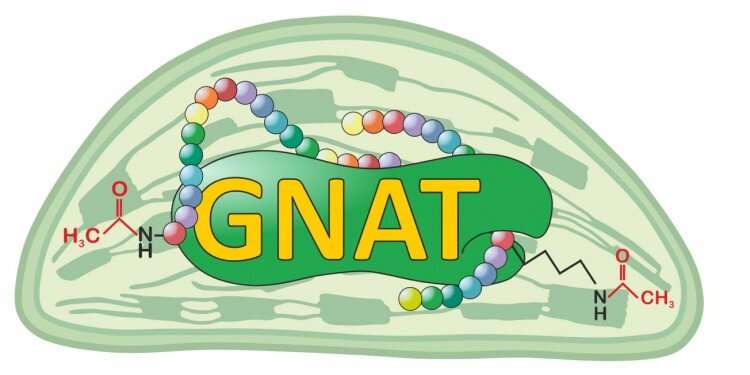Enzymes as double agents: New mechanism discovered in protein modification

Proteins are the workers in a cell and, as the 'basic element of life," are responsible for the most widely varying metabolic processes. In plants, for example, they take on an important function in photosynthesis. In order to be able to work purposefully, proteins change their chemical form after they have been produced in a cell—for example, through protein acetylation, when an acetyl group is transferred to the protein. The role of the 'driver' is played by enzymes, so-called acetyltransferases. Not much is known, however, about the precise mechanisms underlying the process.
An interdisciplinary team of researchers from Germany, Finland and France have now found eight new acetyltransferases in a cell organelle in plants. In doing so, the researchers made a surprising discovery: the enzymes identified are catalytically active in the cell in a twofold way—in other words, they facilitate reactions in different ways. It had previously been assumed that different acetylations were driven by different enzymes.
"Our study shows an entirely new complexity within the enzyme machinery," says Prof. Iris Finkemeier from the University of Münster (Germany), who led the study together with Dr. Carmela Giglione from the University of Paris-Saclay (France). "The results strongly suggest that there are also other enzymes which can display such 'double activities' in eukaryotic cells." For one of the newly identified enzymes, the researchers have already been able to demonstrate that it has an important function in photosynthesis. "Our long-term aim is to understand the processes steered by acetylation and perhaps make photosynthesis more efficient," says Ph.D. student Annika Brünje from Münster University, who is one of the two lead authors of the publication, along with Dr. Willy Bienvenut from the University of Paris-Saclay. The study has been published in the journal Molecular Systems Biology.
For the experiments, the researchers used the model plant Thale Cress (Arabidopsis thaliana). They took a closer look at two important ways of protein modification: so-called N-terminal acetylation and lysine acetylation. In these modifications, an acetyl group is transferred either to the end of the protein called the N-terminus or to the lysine residue. Both processes are very often found in proteins in chloroplasts, which are the cell organelles in which photosynthesis takes place.
In order to find out which enzymes play a role in this process, the researchers first used a protein database to identify possible acetyltransferases, and in addition they located the occurrence of the proteins in the cell (subcellular localization). In this way, they discovered in the chloroplasts a new family of certain acetyltransferases, known as GNAT.
Using quantitative mass spectrometry methods, the researchers were also able to show that the enzymes are active in both the N-terminal acetylation and the lysine acetylation changing the proteins accordingly. Conversely, the researchers noticed that when they deactivated one of the enzymes through genetic modifications, neither of the acetylations functioned properly anymore.
In further studies, the researchers aim initially to discover which functions the individually identified enzymes have. "We expect to discover even more new process in the coming years which these enzymes regulate in the chloroplasts," says Carmela Giglione from the University of Paris-Saclay.
More information: Willy V Bienvenut et al, Dual lysine and N‐terminal acetyltransferases reveal the complexity underpinning protein acetylation, Molecular Systems Biology (2020). DOI: 10.15252/msb.20209464
Journal information: Molecular Systems Biology
Provided by University of Münster


















